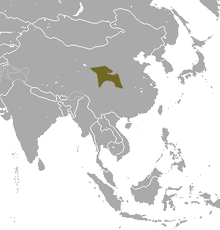Gansu mole
The Gansu mole (Scapanulus oweni) is a species of mammal in the family Talpidae endemic to China, where it occurs in Shaanxi, Gansu, Sichuan, and Qinghai. It is the only species in the genus Scapanulus.[2] The mole is the only member of a tribe of genera commonly known as "New World moles", the Scalopini, not to live in North America.[3]
| Gansu mole | |
|---|---|
| Scientific classification | |
| Kingdom: | Animalia |
| Phylum: | Chordata |
| Class: | Mammalia |
| Order: | Eulipotyphla |
| Family: | Talpidae |
| Genus: | Scapanulus Thomas, 1912 |
| Species: | S. oweni |
| Binomial name | |
| Scapanulus oweni Thomas, 1912 | |
 | |
| Gansu mole range | |
References
- Smith, A.T. & Johnston, C.H. (2016). "Scapanulus oweni". IUCN Red List of Threatened Species. 2016: e.T41472A115188420. doi:10.2305/IUCN.UK.2016-3.RLTS.T41472A22322596.en.{{cite iucn}}: error: |doi= / |page= mismatch (help)
- Hutterer, R. (2005). "Order Soricomorpha". In Wilson, D.E.; Reeder, D.M (eds.). Mammal Species of the World: A Taxonomic and Geographic Reference (3rd ed.). Johns Hopkins University Press. p. 302. ISBN 978-0-8018-8221-0. OCLC 62265494.
- Insectivore Specialist Group 1996. Scapanulus oweni. 2006 IUCN Red List of Threatened Species. Archived June 27, 2014, at the Wayback Machine Downloaded on 30 July 2007.
| Taxon identifiers |
|---|
The morphology of the Gansu mole indicates that it will fall in the Scalopini tribe. All scolopines are distributed in Central America;however, Gansu moles are distributed in the Central and Southwest areas of China.The first specimen of Scapanulus oweni was found by G. Fenwick Owen in 1911 in Gansu, China. The genome of the species is 16,826 bases in length and contains 13 protein-coding genes, 22 transfer genes, 2 ribosomal RNA genes and a displacement loop gene.
<ref>Li, Y., Li, J., & Zhang, Y. (2016). Fossil Scapanulus oweni (Eulipotyphla, Mammalia) from the Shanyangzhai Cave, Middle Pleistocene, Qinhuangdao, China. Quaternary International, 392, 197–202. doi:10.1016/j.quaint.2015.08.001 /ref>
<ref>He, K., Wang, J., Su, W., Li, Q., Nie, W., & Jiang, X. (2012). Karyotype of the Gansu mole (Scapanulus oweni): Further evidence for karyotypic stability in talpid [Abstract]. Karyotype of the Gansu Mole (Scapanulus Oweni): Further Evidence for Karyotypic Stability in Talpid, 37(4), 341–348. doi:10.3106/041.037.0408/ref>
